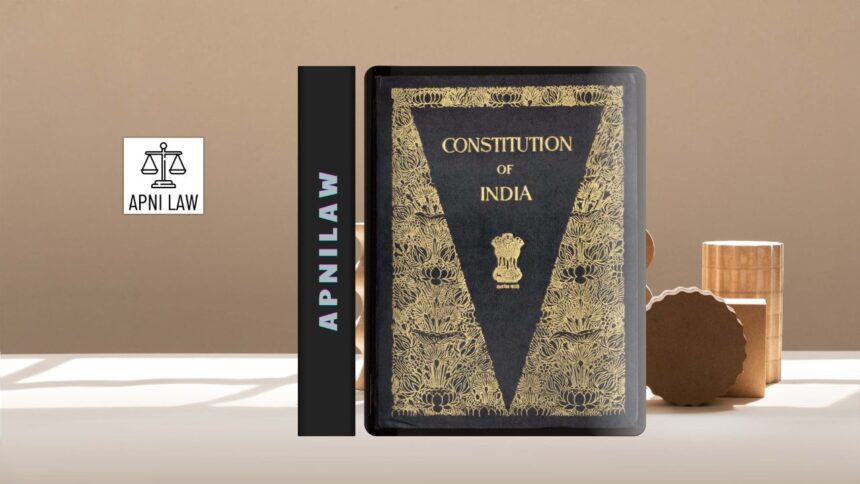Introduction
Water has always been a sensitive and scarce resource in India. Rivers often cross multiple states, and their distribution creates disputes over sharing rights. To handle such conflicts, the Constitution of India introduced a special provision under Article 262. This article empowers Parliament to create laws for adjudicating inter-state river water disputes and also allows it to bar the jurisdiction of regular courts, including the Supreme Court. This ensures that water disputes are settled by expert tribunals and not through prolonged litigation.
What does Article 262 provide?
Article 262 has two clear clauses. The first clause says that Parliament may make laws for adjudicating disputes related to the waters of inter-state rivers or river valleys. The second clause allows Parliament to exclude the jurisdiction of the Supreme Court or any other court over such disputes. This creates a special legal mechanism where technical and political aspects of river water sharing can be considered without interference from routine judicial proceedings.
Why was Article 262 included in the Constitution?
India has a federal structure where rivers flow across multiple states. Each state tries to secure maximum water for agriculture, industries, and drinking purposes. Disputes arise when upstream states hold back or divert water, leaving downstream states in distress. If ordinary courts handled these disputes, they would be burdened with technical issues of hydrology, rainfall, irrigation, and interstate politics. The framers of the Constitution wanted a neutral and expert process. Article 262 was therefore included to create specialized tribunals that could focus only on water issues.
Which law governs inter-state water disputes?
Parliament used its power under Article 262 to pass the Inter-State River Water Disputes Act, 1956. This Act lays down the procedure for resolving conflicts. When negotiations between states fail, a state government can request the Centre to refer the dispute to a tribunal. The Central Government then sets up a Water Tribunal. Once the tribunal gives its decision and it is published by the Centre, the decision becomes final and binding. It carries the same weight as a decree of the Supreme Court. The Act also allows for schemes and authorities to implement tribunal decisions.
How does the tribunal system work?
The tribunal is a quasi-judicial body composed of experts and judges. It hears the claims of each state, examines technical data, and delivers an award. This award is binding on all parties. However, enforcement is often a challenge. States sometimes delay implementation due to political pressure. The Act has been amended several times to strengthen the tribunal system and reduce delays. The most recent amendments introduced a single standing tribunal with multiple benches to ensure faster resolution.
What are some landmark inter-state water disputes?
One of the most famous disputes is the Cauvery water conflict between Karnataka and Tamil Nadu. The tribunal ordered Karnataka to release water to Tamil Nadu. Karnataka attempted to nullify the order through a state ordinance, but the Supreme Court declared the ordinance unconstitutional. This affirmed that tribunal decisions are binding and cannot be set aside by states. The Cauvery case highlighted the authority of tribunals under Article 262.
Other disputes have arisen over major rivers like Krishna, Godavari, Narmada, Ravi-Beas, and Yamuna. Each dispute resulted in the formation of a tribunal. The Narmada Water Dispute led to the creation of the Narmada Water Disputes Tribunal, which allocated shares among Madhya Pradesh, Maharashtra, Gujarat, and Rajasthan. The Ravi-Beas dispute involved Punjab, Haryana, and Rajasthan, and remains contentious due to incomplete implementation.
Can courts interfere in these disputes?
Article 262 allows Parliament to exclude the jurisdiction of the Supreme Court and High Courts in these matters. Once a tribunal is formed, courts cannot adjudicate on the same dispute. However, in some cases, states have approached courts before tribunals were constituted. The judiciary has clarified that once Parliament bars court jurisdiction through legislation, only tribunals can decide these disputes. Courts may intervene only in limited situations, such as reviewing whether a tribunal has acted within its powers.
Why are water disputes so frequent in India?
India’s rivers are unevenly distributed. Some states have perennial rivers, while others rely on seasonal rainfall. Rapid industrialization, urbanization, and population growth increase demand for water. Agriculture, which consumes most of India’s water, puts further strain on river resources. Climate change has also worsened variability in rainfall, leading to droughts in some years and floods in others. States often adopt competitive approaches instead of cooperative ones, which intensifies conflicts.
How effective is the Inter-State River Water Disputes Act?
The Act provides a structured process, but delays are common. Tribunals often take many years to give an award. Implementation is even more difficult, as states resist sharing water. Political factors make compliance harder, especially when elections are near. For example, in the Cauvery dispute, protests erupted in Karnataka whenever water had to be released. Although the Act gives tribunal decisions the force of a Supreme Court decree, lack of enforcement mechanisms has weakened its effectiveness.
What reforms have been suggested?
Several reforms have been proposed to strengthen the system. The Punchhi Commission recommended better coordination and quicker resolution. Recent amendments introduced a permanent tribunal with multiple benches to handle cases faster. There have also been suggestions for an independent authority to monitor the implementation of tribunal awards. Experts argue that cooperative federalism and dialogue between states must accompany legal solutions. Without political will, even strong laws cannot prevent recurring disputes.
How do these disputes impact ordinary people?
Water disputes directly affect farmers, industries, and households. In states like Tamil Nadu and Karnataka, farmers depend heavily on river water for crops like paddy and sugarcane. When water is withheld, crops fail, leading to economic losses and farmer distress. Urban areas also suffer from water shortages. Protests and agitations sometimes turn violent, disrupting law and order. Thus, these disputes are not just legal or political issues but matters that touch millions of lives.
How has the Supreme Court balanced its role?
Although Article 262 excludes the Supreme Court’s jurisdiction, the Court has occasionally stepped in to interpret tribunal awards or resolve implementation issues. In the Cauvery dispute, the Court modified the quantum of water to be shared and directed the Centre to create a regulatory body. The Court clarified that while it respects the bar on jurisdiction, it can ensure enforcement of tribunal awards in exceptional circumstances. This balance maintains the supremacy of constitutional mechanisms while safeguarding justice.
Why is cooperative federalism important in water sharing?
India’s federal system relies on cooperation between states. Rivers do not recognize political boundaries. When states treat rivers as shared resources rather than exclusive property, disputes can be reduced. Mechanisms like river boards, inter-state councils, and joint water management projects encourage collaboration. Cooperative federalism ensures that water is shared fairly, disputes are minimized, and development is balanced across regions.
Conclusion
Article 262 is a vital constitutional safeguard for handling inter-state water disputes in India. It empowers Parliament to create laws and tribunals for resolving conflicts, while excluding courts to ensure a specialized and technical process. The Inter-State River Water Disputes Act, 1956, serves as the backbone of this system. Landmark cases like the Cauvery dispute show the binding nature of tribunal awards and the limits of state powers. However, frequent disputes, delays in tribunal decisions, and weak enforcement remain challenges. Effective reforms, cooperative federalism, and stronger implementation mechanisms are essential to ensure that rivers become bridges of unity rather than sources of conflict.








